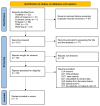'One Stop' Therapy has a Satisfying Performance on AF Patients with Interatrial Communication: Evidence from Pooled Clinical Experience
- PMID: 40351666
- PMCID: PMC12059784
- DOI: 10.31083/RCM26662
'One Stop' Therapy has a Satisfying Performance on AF Patients with Interatrial Communication: Evidence from Pooled Clinical Experience
Abstract
Background: Left atrial appendage closure (LAAC) has been reported to be a viable alternative to prevent thromboembolic events for atrial fibrillation (AF) patients. Interatrial communication closure, such as atrial septal defect (ASD) and patent foramen ovale (PFO) closure could significantly decrease the occurrence of stroke. For AF patients with interatrial communication, the success rate as well as the long-term outcomes of 'One stop' closure remain elusive.
Methods: Studies were systematically screened using online databases (including PubMed, Cochrane Library, Web of Science, Embase, China National Knowledge Infrastructure (CNKI) database, and WanFang database) from their establishment to 1st August 2024. We utilized a fixed-effect model to synthesize the success rate and the long-term outcomes. Subgroup analysis was performed to identify the potential confounders.
Results: A total of 7 studies comprising 156 patients were included. ASD/PFO closure combined with LAAC showed a high degree of feasibility, with a success rate of 1.00 (95% CI: 0.99, 1.00; p < 0.001). Meanwhile, 'One stop' ASD/PFO closure combined with LAAC exhibited a high long-term safety and a low occurrence of complications. Moreover, subgroup analysis revealed that the bleeding event occurrence was relatively higher in the male proportion ≥50% subgroup and HAS-BLED score ≥3 subgroup, respectively.
Conclusions: ASD/PFO closure combined with LAAC has a satisfying performance on AF patients with interatrial communication.
The prospero registration: CRD42023462221, https://www.crd.york.ac.uk/prospero/display_record.php?ID=CRD42023462221.
Keywords: ASD closure; LAAC; PFO closure; atrial fibrillation; atrial septal defect closure; left atrial appendage closure; patent foramen ovale closure.
Copyright: © 2025 The Author(s). Published by IMR Press.
Conflict of interest statement
The authors declare no conflict of interest.
Figures






Similar articles
-
The feasibility and safety of combining atrial septal defect/patent foramen ovale and left atrial appendage closure: A systematic review and meta-analysis.Front Cardiovasc Med. 2023 Jan 6;9:1080257. doi: 10.3389/fcvm.2022.1080257. eCollection 2022. Front Cardiovasc Med. 2023. PMID: 36684606 Free PMC article.
-
"One-stop shop": safety and efficacy of combining atrial septal defect occlusion and left atrial appendage closure for patients with atrial septal defect and atrial fibrillation.BMC Cardiovasc Disord. 2020 Oct 12;20(1):444. doi: 10.1186/s12872-020-01708-6. BMC Cardiovasc Disord. 2020. PMID: 33045999 Free PMC article.
-
Presence of patent foramen ovale does not increase cerebrovascular event rates in patients with atrial fibrillation following left atrial appendage closure.Heliyon. 2024 Nov 8;10(22):e40248. doi: 10.1016/j.heliyon.2024.e40248. eCollection 2024 Nov 30. Heliyon. 2024. PMID: 39624313 Free PMC article.
-
[Safety and efficacy of left atrial appendage closure combined with patent foramen ovale closure for atrial fibrillation patients with patent foramen ovale].Zhonghua Xin Xue Guan Bing Za Zhi. 2022 Mar 24;50(3):257-262. doi: 10.3760/cma.j.cn112148-20211214-01073. Zhonghua Xin Xue Guan Bing Za Zhi. 2022. PMID: 35340144 Chinese.
-
Impact of Percutaneous Closure of Interatrial Shunts on Migraine Attacks: Single-Operator Series and Review of the Literature.Rev Recent Clin Trials. 2017;12(2):129-138. doi: 10.2174/1574887112666170328124939. Rev Recent Clin Trials. 2017. PMID: 28356032 Review.
References
Publication types
LinkOut - more resources
Full Text Sources

